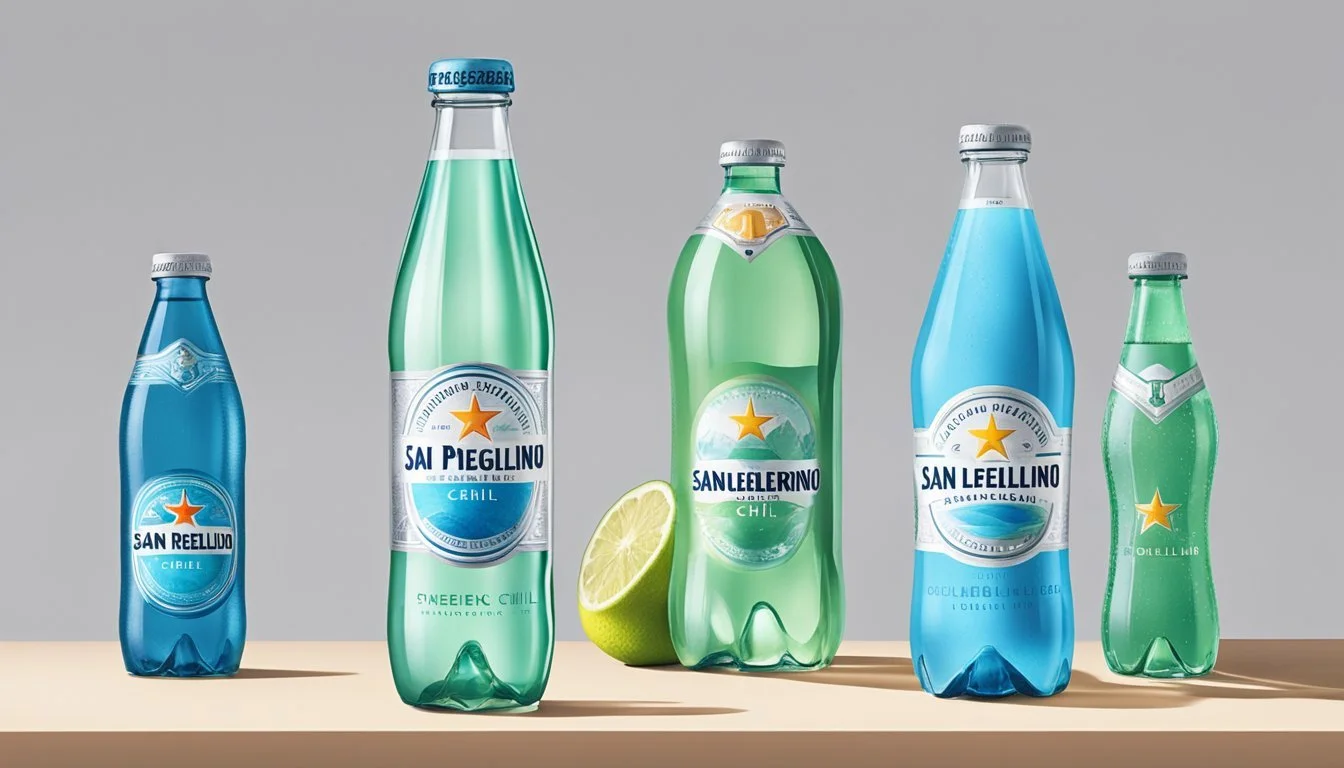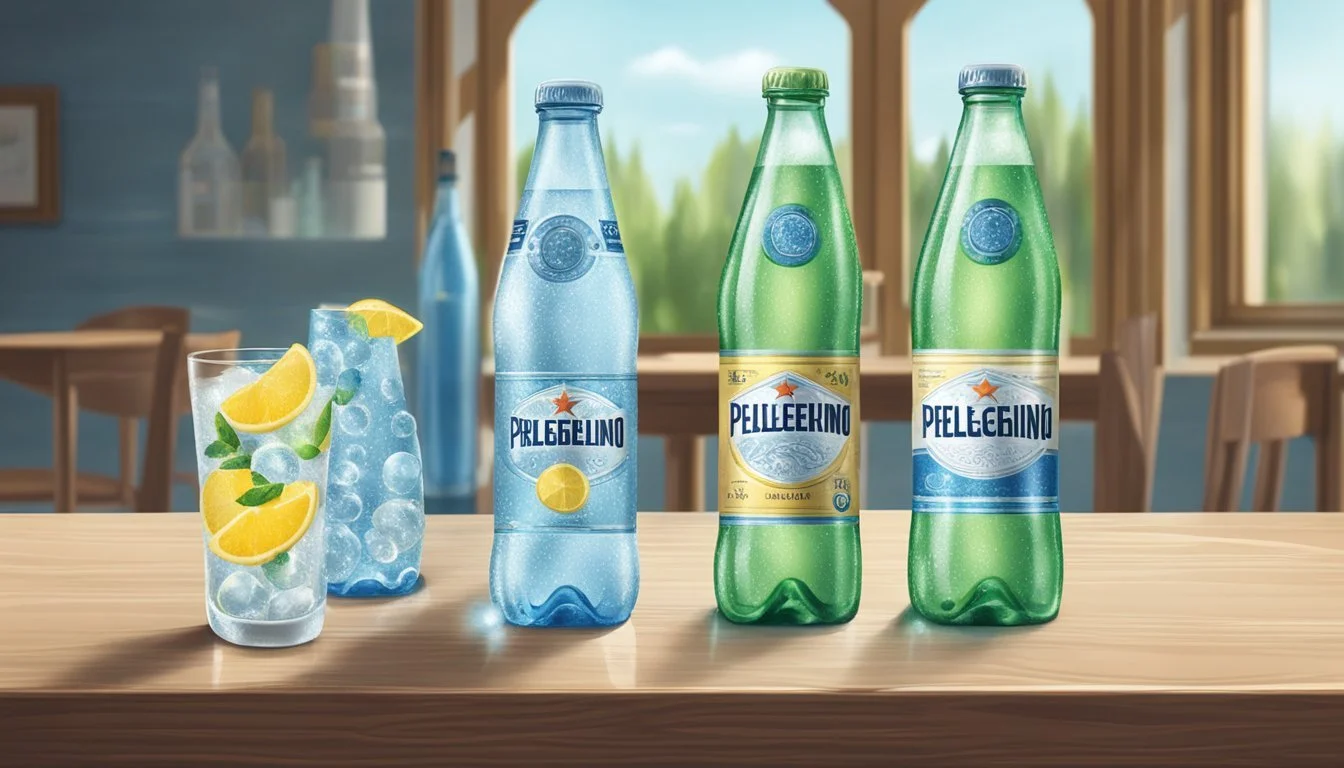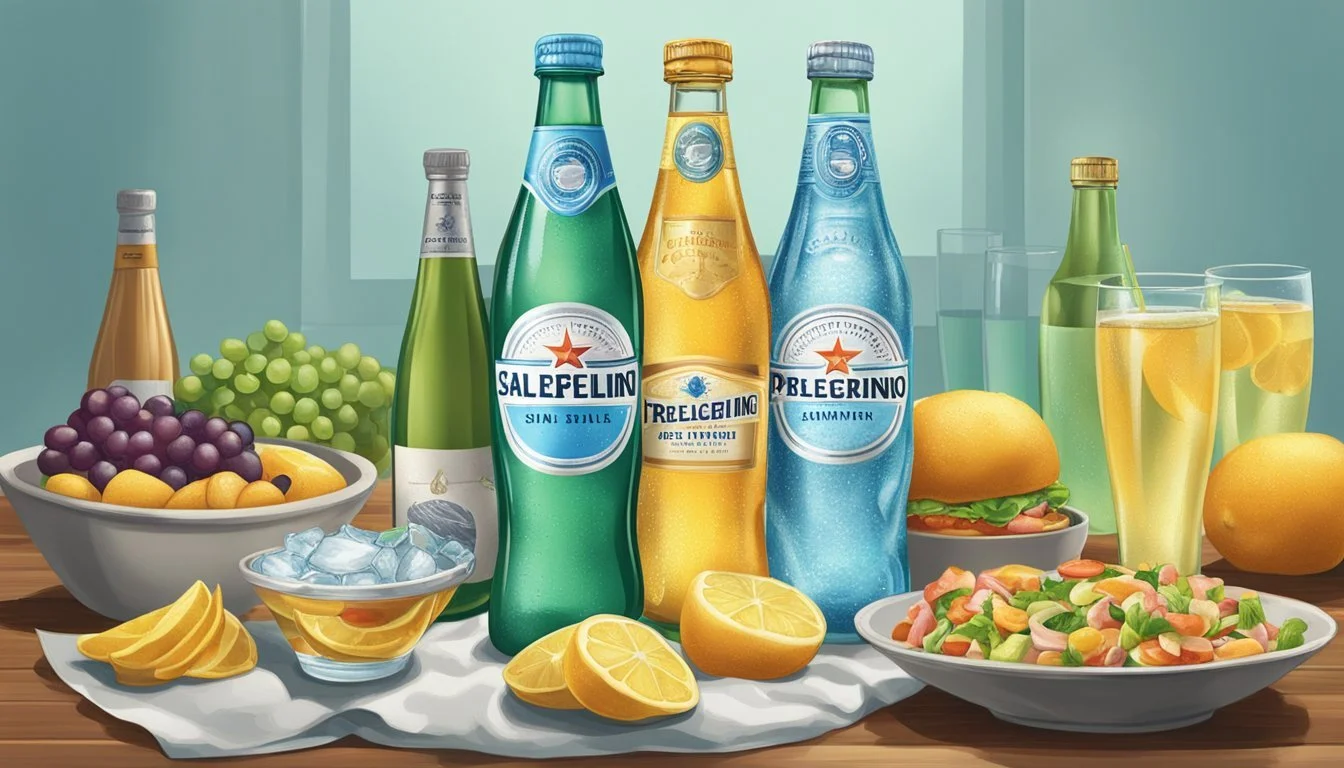San Pellegrino vs. Big Chill
Comparing the Best Bottled Waters
Choosing between San Pellegrino and Big Chill can be challenging for those who prioritize taste and quality in their bottled water. San Pellegrino, renowned for its sparkling options, offers a sophisticated experience with its subtly mineralized taste and effervescent bubbles.
Big Chill, on the other hand, is known for its purity and refreshingly smooth taste, often preferred by individuals who enjoy still water. While San Pellegrino provides a more distinctive, bubbly refreshment, Big Chill excels in delivering a straightforward, clean hydration experience.
When considering which bottled water is better, much depends on personal preference and the occasion. For those looking to add a luxurious touch to their beverage selection, San Pellegrino might be the go-to choice. Meanwhile, Big Chill's simplicity and purity may win over those seeking a pure and unobtrusive taste.
The Essence of Sparkling Water
Sparkling water provides a refreshing experience through carbonation and offers various health benefits due to its mineral content. This segment will delve into the intricacies of carbonation and the contribution of minerals to health.
Understanding Carbonation
Carbonation involves dissolving carbon dioxide (CO₂) in water under pressure. This process creates bubbles, lending sparkling water its unique fizz. The sensation is both tactile and auditory, which many people find appealing.
Sparkling water can be naturally carbonated, like certain mineral waters, or artificially carbonated, where CO₂ is added. The level of carbonation varies between brands, influencing the perceived sharpness and mouthfeel. Reduced carbonation often leads to a smoother taste profile, while higher levels result in a more pronounced fizzy experience.
Minerals and Health Benefits
Mineral water derives its name from the natural minerals found in it. Key minerals include calcium, magnesium, and potassium, which serve as essential electrolytes. These minerals help regulate vital functions such as muscle contraction, heart rhythm, and hydration balance.
Sparkling mineral water like San Pellegrino offers these benefits along with a pleasant, subtle flavor due to its mineral content. The electrolytes present also aid in quicker rehydration compared to plain water. The presence of these minerals can enhance the overall drinking experience, making it both enjoyable and healthful.
By focusing on the carbonation and mineral benefits, sparkling water offers a unique blend of refreshing taste and potential health advantages.
San Pellegrino: An Italian Classic
San Pellegrino's heritage and distinctive characteristics make it a favorite in fine dining. This section covers the origin, mineral content, and culinary significance of this iconic beverage.
Origin and History of San Pellegrino
San Pellegrino originates from the town of San Pellegrino Terme, located in the Bergamo province of Italy. Since 1899, this brand has been synonymous with high-quality mineral water. The water is sourced from natural springs in the Italian Alps, ensuring its purity.
The brand's early history is linked with the era of European spa culture, where mineral springs were believed to have therapeutic properties. San Pellegrino quickly gained a reputation for its crisp, refreshing taste.
Unique Qualities and Mineral Content
San Pellegrino water is renowned for its unique mineral composition. It naturally contains calcium, magnesium, sodium, and bicarbonates, which contribute to its distinctive flavor profile.
Calcium: 208 mg/L
Magnesium: 56 mg/L
Sodium: 33.3 mg/L
Bicarbonates: 964 mg/L
The water's effervescence, achieved through the addition of natural CO₂, adds a sparkling quality that enhances its palate-cleansing attributes. This balance of minerals provides a crisp and slightly tangy taste.
San Pellegrino in the Culinary World
San Pellegrino holds a special place in the culinary world. It is frequently served in restaurants and during fine dining experiences, complementing a variety of dishes. The water's ability to cleanse the palate makes it essential in settings where food and wine pairings are key.
Chefs and sommeliers often choose San Pellegrino for its ability to amplify the flavors of Italian cuisine. From Tuscany to international dining tables, this mineral water continues to be a symbol of elegance and quality, cementing its legacy in the world of gastronomy.
Comparing Carbonated Contenders
When comparing San Pellegrino and Big Chill, it's important to consider factors such as taste, price, and environmental impact. Both offer unique attributes that cater to different consumer preferences.
Big Chill: The Modern Challenger
Big Chill has emerged as a popular choice among sparkling water enthusiasts. It is known for its crisp, clean taste and refreshing carbonation.
Sourced from pure mineral springs, Big Chill markets itself as providing a healthy option with natural minerals. Available in both glass and plastic bottles, it appeals to eco-conscious consumers with its sustainable packaging options.
A Taste Test Showdown
Taste is a significant deciding factor when it comes to choosing between these two brands.
San Pellegrino is celebrated for its fine bubbles and subtle mineral flavor, which comes from the Italian Alps. On the other hand, Big Chill boasts a more robust carbonation and a crisper taste, making it a favorite among those who prefer a stronger bubbly sensation.
Price Point Analysis
Price varies significantly between these two brands. San Pellegrino, with its storied reputation, tends to be on the higher end of the market.
Big Chill offers a more affordable price point, making it accessible to a wider audience. This affordability does not come at the cost of quality, as Big Chill prides itself on maintaining superior taste and freshness.
Environmental Impact and Sustainability
San Pellegrino and Big Chill both prioritize sustainability but in different ways. San Pellegrino mainly uses glass bottles, which are recyclable and have a lower carbon footprint.
Big Chill, while offering glass options, also provides plastic bottles that are BPA-free and designed to be easily recyclable. Additionally, Big Chill emphasizes responsible sourcing and sustainable manufacturing practices to reduce its environmental impact.
This section highlights the strengths of both San Pellegrino and Big Chill, focusing on their taste, pricing, and commitment to sustainability. Readers seeking a carbonated beverage can weigh these factors based on their personal preferences and values.
Beyond the Bubbles
San Pellegrino and Big Chill offer unique qualities beyond their effervescence. Their flavored variants and health-conscious options cater to diverse preferences and dietary needs.
Flavored Variants and Pairings
San Pellegrino is renowned for its subtly flavored sparkling waters. Limonata, Aranciata, and Pompelmo are favorites, crafted with real fruit juice. These beverages pair beautifully with light dishes such as salads, seafood, or Italian cuisine, enhancing the dining experience.
Big Chill, while less known for flavored options, provides refreshing alternatives. Their cucumber-mint and lemon-lime flavors are light and invigorating. Big Chill’s natural and mild flavor profile complements day-to-day hydration perfectly. The minimalistic flavoring appeals to those seeking a subtle taste that does not overpower their palate.
Health-Conscious Alternatives
San Pellegrino offers zero-calorie alternatives like San Pellegrino Essenza. These beverages contain natural flavors without added sugars or artificial sweeteners, making them suitable for calorie-conscious individuals. The inclusion of potassium, calcium, sodium, and magnesium in their water also offers additional health benefits, making it a well-rounded choice.
Big Chill promotes its water's purity and absence of artificial additives. Their health-focused options include sugar-free and zero-calorie variations. Big Chill’s emphasis on pure hydration without added sugars aligns with those aiming to maintain a clean diet. This makes it an appealing option for those watching their calorie intake without compromising taste.
A Connoisseur’s Perspective
A detailed analysis of bottled water evaluates both the sensory experience and the context in which it is served. For a true connoisseur, aspects like mineral content, carbonation, and the setting are essential.
The Role of a Water Sommelier
A water sommelier is an expert in the subtleties of water tasting. They evaluate factors such as mineral composition, carbonation levels, and mouthfeel. San Pellegrino, sourced from the Italian Alps, is rich in minerals like calcium and potassium, providing a slightly salty taste profile.
A sommelier's knowledge extends to pairings, akin to wine. For instance, San Pellegrino's mineral-rich content contrasts well with certain foods. The slight acidity in San Pellegrino, with a pH of 4.28, offers a refreshing bite that complements rich, savory dishes.
Fine Dining and Bottled Waters
In fine dining, the choice of water can elevate the dining experience. San Pellegrino is often the preferred choice over brands like La Croix and Perrier due to its sophisticated taste and elegant presentation. Its bubbles are small and persistent, enhancing the texture.
High-end restaurants frequently select San Pellegrino not only for its flavor but also for its reputation. The brand’s association with luxury and quality makes it a staple in establishments that prioritize an exceptional dining atmosphere.
San Pellegrino’s versatility makes it a popular choice for both standalone consumption and as a mixer in cocktails. Its balanced mineral composition complements a variety of beverages, enhancing the overall dining experience.
Exploration of Brands and Alternatives
San Pellegrino faces tough competition in the bottled water market, and it’s essential to consider various other brands and types of water. This section will cover popular brands like La Croix and Liquid Death, as well as the diverse water varieties available.
From La Croix to Liquid Death: A Market Overview
The world of sparkling water is vast and diverse. La Croix has made a significant mark with its range of flavors and attractive packaging. It's known for being a zero-calorie, zero-sweetener option, appealing to health-conscious consumers.
Liquid Death, despite its edgy branding, focuses on being eco-friendly by offering water in recyclable cans. It markets itself as “murdering” your thirst with spring water sourced from the Austrian Alps.
Other contenders like Topo Chico provide highly carbonated mineral water, which has a cult following due to its crisp taste and significant fizz. Icelandic Glacial offers still and sparkling options, sourced from Iceland's pristine springs, emphasizing purity and low mineral content.
Waterloo Sparkling Water and Perrier are other notable mentions, each offering unique flavors and levels of carbonation. The variety within these brands showcases the market's commitment to catering to different tastes and preferences.
Understanding the Appeal of Varieties
Different types of water appeal to different consumer needs. Sparkling waters like San Pellegrino and La Croix are favored for their fizz and flavor options, making them excellent alternatives to sugary sodas.
Seltzer waters, such as those offered by Waterloo, provide a straightforward, unflavored bubbly experience, often used as mixers in beverages or enjoyed plain.
Club soda contains added minerals like sodium bicarbonate, giving it a slightly salty taste, and is commonly used in cocktail recipes.
Still waters like Fiji and Icelandic Glacial are chosen for their purity and natural taste, often sourced from natural springs.
Canned waters are gaining popularity for their eco-friendliness, reducing plastic waste. Brands like Liquid Death are paving the way by offering water in aluminum cans, making sustainability a key selling point.
Each brand and variety brings something unique, meeting diverse hydration needs and preferences.
More About San Pellegrino
Acqua Panna vs San Pellegrino: Which Bottled Water is Better?
Boxed Water vs San Pellegrino: Which Bottled Water is Better?
Core Hydration vs San Pellegrino: Which Bottled Water is Better?
Ice Mountain vs San Pellegrino: Which Bottled Water is Better?
Icelandic Glacial vs San Pellegrino: Which Bottled Water is Better?
Just Water vs San Pellegrino: Which Bottled Water is Better?
Mountain Valley Spring Water vs San Pellegrino: Which Bottled Water is Better?
Nestle Pure Life vs San Pellegrino: Which Bottled Water is Better?
Poland Spring vs San Pellegrino: Which Bottled Water is Better?
San Pellegrino vs Alkaline88: Which Bottled Water is Better?
San Pellegrino vs Aqua Carpatica: Which Bottled Water is Better?
San Pellegrino vs Cascade Mountain: Which Bottled Water is Better?
San Pellegrino vs Castle Rock: Which Bottled Water is Better?
San Pellegrino vs CBD Living: Which Bottled Water is Better?
San Pellegrino vs Crystal Geyser: Which Bottled Water is Better?
San Pellegrino vs Crystal Lake: Which Bottled Water is Better?
San Pellegrino vs Essence pH10: Which Bottled Water is Better?
San Pellegrino vs Hawaii Volcanic: Which Bottled Water is Better?
San Pellegrino vs Hawaiian Springs: Which Bottled Water is Better?
San Pellegrino vs Kirkland Signature: Which Bottled Water is Better?
San Pellegrino vs Liquid Death: Which Bottled Water is Better?
San Pellegrino vs Open Water: Which Bottled Water is Better?
San Pellegrino vs Proud Source: Which Bottled Water is Better?
San Pellegrino vs Purely Sedona: Which Bottled Water is Better?
San Pellegrino vs Richard's Rainwater: Which Bottled Water is Better?
San Pellegrino vs Simple Truth: Which Bottled Water is Better?
San Pellegrino vs Smartwater: Which Bottled Water is Better?
San Pellegrino vs Solan de Cabras: Which Bottled Water is Better?
San Pellegrino vs Talking Rain AQA: Which Bottled Water is Better?
San Pellegrino vs Topo Chico: Which Bottled Water is Better?
San Pellegrino vs Weird Water: Which Bottled Water is Better?
San Pellegrino vs Whole Foods 365: Which Bottled Water is Better?
San Pellegrino vs Whole Foods Italian Still Mineral water: Which Bottled Water is Better?
San Pellegrino vs Zephyrhills: Which Bottled Water is Better?
More About Big Chill
Big Chill vs Kirkland Signature: Which Bottled Water is Better?
Big Chill vs Talking Rain AQA: Which Bottled Water is Better?
Big Chill vs Whole Foods 365: Which Bottled Water is Better?
Cascade Mountain vs Big Chill: Which Bottled Water is Better?
Hawaii Volcanic vs Big Chill: Which Bottled Water is Better?
Hawaiian Springs vs Big Chill: Which Bottled Water is Better?
Icelandic Glacial vs Big Chill: Which Bottled Water is Better?
Mountain Valley Spring Water vs Big Chill: Which Bottled Water is Better?
Nestle Pure Life vs Big Chill: Which Bottled Water is Better?
Richard's Rainwater vs Big Chill: Which Bottled Water is Better?
Solan de Cabras vs Big Chill: Which Bottled Water is Better?
Whole Foods Italian Still Mineral water vs Big Chill: Which Bottled Water is Better?





